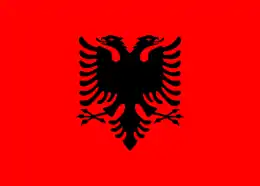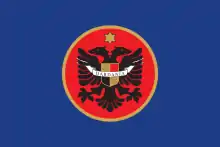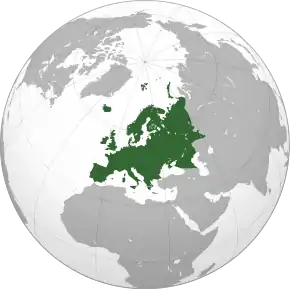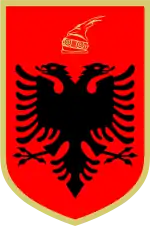Flag of Albania
The Flag of Albania (Albanian: Flamuri i Shqipërisë) is a red flag with a silhouetted black double-headed eagle in the centre. The red stands for bravery, strength, valour and bloodshed, while the double-headed eagle represents the sovereign state of Albania. The flag was established as the national flag of Albania when the country gained its independence from the Ottoman empire in 1912.
 | |
| Name | Flamuri Kombëtar |
|---|---|
| Use | National flag |
| Proportion | 5:7 (1:1.4 in the law) |
| Adopted | 1912 11 January 1946 (with the star) 7 April 1992 (star removed) 22 July 2002 (standardization)[1] |
| Design | A red field with a black two-headed eagle at the center.[2] |
| Designed by | Sadik Kaceli on the eve of the National Assembly of January 11, 1946, the day when Albania was declared a People's Republic.[3] |
History

During John Hunyadi’s campaign in Niš in 1443, Skanderbeg and a few hundred Albanians defected from the Turkish ranks; for twenty-five years he scored remarkable victories against the Ottomans. He adopted the similar Byzantine imperial flag , with the double-headed eagle and the red background , and his spectacular victories brought him the papal title Athleta Christi.[5] The eagle was used for heraldic purposes in the Middle Ages by a number of noble families in Albania and became the symbol of the Albanians.[6] The Kastrioti's coat of arms, depicting a black double-headed eagle on a red field, became famous when he led a revolt against the Ottoman Empire resulting in the independence of Albania from 1443 to 1479. This was the flag of the League of Lezhë, which was the first unified Albanian state in the Middle Ages and the oldest representative political body in the country with extant records.[7][8][9][10]
The symbol of the double-headed eagle was re-used by Albanian nationalists during the 18th, 19th and early 20th centuries as a symbol of their campaign for their country's independence from the Ottoman Empire.[11][6] On 28 November 1912, the Albanian Declaration of Independence was proclaimed in Vlora and the flag, raised by Ismail Qemali, was adopted as the symbol of the new nation.[11][6]
The Albanian flag has gone through a number of changes over the years as different regimes have modified it. During the reign of King Zog (r. 1928–1939), a crown was added to the flag and was replaced by two fasces during the Italian occupation of Albania. After World War II, the communist regime added a five-pointed golden star, which was removed on 7 April 1992 after the communist government in Albania collapsed.
Albania's maritime flags—the civil ensign and the naval ensign—are both different from the national flag. The civil ensign consists of three horizontal bands of red, black, and red. The naval ensign is similar to the national flag, except that the eagle is on a white field, and the lower portion of the flag has a red stripe. The eagle of the flag of Albania is depicted on the reverse of the Albanian five lekë coin, issued in 1995 and 2000.[12]
Beginning in 1969, the flag of Albania was widely unofficially flown in Kosovo by the country's ethnic Albanian population.[13] It was the symbol of the unrecognised Republic of Kosova during the 1990s. The current independent state of Kosovo uses a different flag that was designed to avoid any symbols associated with a particular ethnic group, similarly to the flags of Bosnia and Herzegovina and Cyprus.
Specifications
Law 8926 from 22 July 2002 sets the standard CMYK red for the flag:[14]
Colors scheme |
Red | Black |
|---|---|---|
| CMYK | 0/100/100/0 | 0/0/0/100 |
Gallery
Chronological
.svg.png.webp) Flag used during the Albanian National Awakening in the 19th and early 20th centuries.[15]
Flag used during the Albanian National Awakening in the 19th and early 20th centuries.[15].svg.png.webp) Flag of Independent Albania (1912–1914).
Flag of Independent Albania (1912–1914). Alternate flag of Independent Albania (1912).
Alternate flag of Independent Albania (1912)..svg.png.webp) Flag of Albania (1912–1937).
Flag of Albania (1912–1937)..svg.png.webp) Flag of the Principality of Albania (1914–1920).
Flag of the Principality of Albania (1914–1920). De facto flag of the Principality of Albania (Sep 1914-1915).
De facto flag of the Principality of Albania (Sep 1914-1915)..svg.png.webp) Flag of the Principality of Albania (1920–1925) and the Albanian Republic (1925–1926).
Flag of the Principality of Albania (1920–1925) and the Albanian Republic (1925–1926)..svg.png.webp) Flag of the Albanian Republic (1926–1928).
Flag of the Albanian Republic (1926–1928)..svg.png.webp) Flag of the Albanian Kingdom (1928–1939).
Flag of the Albanian Kingdom (1928–1939)..svg.png.webp) Flag of the Albanian Kingdom under Italy (1939–1943).
Flag of the Albanian Kingdom under Italy (1939–1943)..svg.png.webp) Flag of Albania under German occupation.
Flag of Albania under German occupation..svg.png.webp) Flag of the Democratic Government of Albania (1944–1946)
Flag of the Democratic Government of Albania (1944–1946).svg.png.webp) Flag of the People's Socialist Republic of Albania (1946–1992).
Flag of the People's Socialist Republic of Albania (1946–1992)..svg.png.webp) Flag of the Republic of Albania (1992–2002).
Flag of the Republic of Albania (1992–2002). Flag of the Republic of Albania (2002–present).
Flag of the Republic of Albania (2002–present).
Other
 Flag of Albanian Muslims during the first quarter of the 19th century
Flag of Albanian Muslims during the first quarter of the 19th century_Merchant_Flag_1453-1793.svg.png.webp) Latin (usually Albanian) Merchant Flag 1453–1793 during Ottoman Albania.
Latin (usually Albanian) Merchant Flag 1453–1793 during Ottoman Albania. Republic of Central Albania, short-lived unrecognised state created by Essad Pasha Toptani.
Republic of Central Albania, short-lived unrecognised state created by Essad Pasha Toptani. Autonomous Albanian Republic of Korçë, an autonomous state.
Autonomous Albanian Republic of Korçë, an autonomous state. Flag of the Republic of Mirdita, a short-lived, unrecognised republic created by Marka Gjoni.
Flag of the Republic of Mirdita, a short-lived, unrecognised republic created by Marka Gjoni..svg.png.webp) Flag of Albania under Italy (1939–1943), crowned version of the House of Savoy.
Flag of Albania under Italy (1939–1943), crowned version of the House of Savoy. Flag of Socialist Federal Republic of Yugoslavia Albanian Minority (Socialist Autonomous Province of Kosovo).
Flag of Socialist Federal Republic of Yugoslavia Albanian Minority (Socialist Autonomous Province of Kosovo)..svg.png.webp) Flag of the Republic of Kosova.
Flag of the Republic of Kosova. Flag of Dardania, which served as a flag of the Republic of Kosova, and Presidential Flag under UNMIK, created by Ibrahim Rugova.
Flag of Dardania, which served as a flag of the Republic of Kosova, and Presidential Flag under UNMIK, created by Ibrahim Rugova. Flag used by the Arbëreshë (unofficial).
Flag used by the Arbëreshë (unofficial).
References
- "File:Ligji 8926 22.07.2002.pdf - Wikimedia Commons" (PDF). Commons.wikimedia.org. Retrieved 20 January 2020.
- Law #8926, 22.07.2002 (pages 3-4: CMYK: 0-100-100-0)
- Një flamur kombëtar që vjen nga legjenda 100 vjeçare
- Nadin, Lucia (2013). Venezia e Albania: una storia di incontri e secolari legami. Regione del Veneto. p. 96. ISBN 978-88-97784-35-7.
- Mucha, Crampton & Louda 1985, p. 36.
- Elsie 2010, "Flag, Albanian", p. 140: "The eagle was a common heraldic symbol for many Albanian dynasties in the Late Middle Ages and came to be a symbol of the Albanians in general. It is also said to have been the flag of Skanderbeg...As a symbol of modern Albania, the flag began to be seen during the years of the national awakening and was in common use during the uprisings of 1909-1912. It was this flag that Ismail Qemal bey Vlora raised in Vlora on 28 November 1912 in proclaiming Albanian independence."
- Matanov 2010, p. 363.
- Pickard & Çeliku 2008, p. 16.
- Schmitt 2009.
- "Kuvendi i Lezhës (1444)". letersia.fajtori.com (in Albanian).
- Elsie 2001, "Eagles", p. 78.
- "Albanian coins in circulation – Issue of 1995, 1996 and 2000". Bank of Albania. 2004–2009. Archived from the original on 6 March 2009. Retrieved 9 March 2012.
- Malcolm 1998, p. 325.
- Law 8926 22.07.2002.
- "Albania: Ottoman rule (15th century-1912)". Retrieved 4 March 2015.
In the 19th century, the Albanian independentist circles used a red flag with the Byzantine double-headed eagle, supposedly used by the Albanian medieval hero Skanderbeg, and never forgotten in Albania. This flag was also used by the Albanian chief Isa Boletin, when he rebelled against Turkey in 1910. When the Autonomous Government was proclaimed in Mirditë in June 1911, this was also the flag used.
Sources
- Elsie, Robert (2010). Historical Dictionary of Albania. Lanham, MD: Scarecrow Press (The Rowman & Littlefield Publishing Group Incorporated). ISBN 978-0-8108-6188-6.
- Elsie, Robert (2001). A Dictionary of Albanian Religion, Mythology, and Folk Culture. New York, NY: New York University Press. ISBN 0-8147-2214-8.
- Grumeza, Ion (2010). The Roots of Balkanization: Eastern Europe C.E. 500–1500. Lanham, MD: University Press of America. ISBN 978-0-7618-5134-9.
- Malcolm, Noel (1998). Kosovo: A Short History. London: Macmillan. ISBN 0-333-66612-7.
- Matanov, Christo (2010). The Oxford Encyclopedia of Medieval Warfare and Military Technology. Oxford: Oxford University Press. ISBN 978-0-19-533403-6.
- Mucha, Ludvík; Crampton, William; Louda, Jiří (1985). Webster's Concise Encyclopedia of Flags & Coats of Arms. New York, NY: Crescent Books. ISBN 0-517-49951-7.
- Pickard, Rob; Çeliku, Florent (2008). Analysis and Reform of Cultural Heritage Policies in South-East Europe. Strasbourg: Council of Europe Publishing. ISBN 978-9-28-716265-6.
- Schmitt, Oliver Jens (2009). Skanderbeg: Der neue Alexander auf dem Balkan (in German). Regensburg: Verlag Friedrich Pustet. ISBN 978-3-7917-2229-0.
Further reading
- Frashëri, Kristo (2002). Gjergj Kastrioti Skënderbeu: Jeta dhe Vepra, 1405–1468 (in Albanian). Tirana, Albania: Botimet Toena. ISBN 99927-1-627-4.
External links
| Wikimedia Commons has media related to Flags of Albania. |

